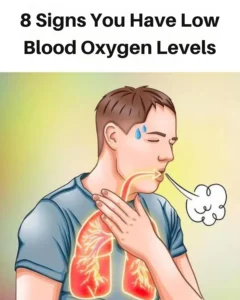A Word of Caution
While these foods can be part of a heart-healthy diet, they’re not substitutes for medical treatment. If you’re currently on prescribed anticoagulants, talk to your doctor before making dietary changes, as natural blood thinners can interact with medications.
Final Thoughts
Eating well is a powerful act of prevention. By incorporating these seven natural ingredients into your daily meals, you’re giving your body tools to support healthy circulation and heart function. Start slowly, enjoy the flavors, and use moderation—your body will respond with gratitude.
8 Warning Signs of Low Blood Oxygen Levels

Oxygen is crucial for survival. As you breathe, your lungs absorb this essential element and transport it via red blood cells to nourish all organs and tissues. However, low oxygen levels in the blood can lead to severe health issues, affecting vital organs such as the heart, liver, and brain.
But what causes this condition? What warning signs should you watch for? This article explores the key factors behind low oxygen levels and provides practical solutions to enhance your well-being.
Causes of Low Blood Oxygen
Chronic lung conditions: Diseases like asthma, bronchitis, emphysema, COPD, or pneumonia can impair oxygen absorption in the lungs.
Smoking: Cigarette smoke decreases hemoglobin’s efficiency in transporting oxygen.
Stress and anxiety: Elevated cortisol levels can trigger hyperventilation, disrupting the oxygen-carbon dioxide balance.
Sleep apnea: Snoring or apnea episodes limit nighttime oxygen intake, leading to periodic low oxygen levels.
Excess sugar: A diet high in refined carbs can acidify the blood, hindering oxygen diffusion.
Nutrient deficiencies: A lack of essential vitamins and minerals, such as vitamins E, B1, B12, D, C, iron, or zinc, can lead to anemia and impair oxygen transport.

8 Signs of Low Oxygen Levels
1. Shortness of breath (Dyspnea) – Difficulty breathing, chest tightness, and frequent sighing indicate oxygen deprivation.
2. Dizziness and weakness – Feeling lightheaded or experiencing muscle fatigue suggests inadequate oxygen supply to the brain and muscles.
3. Rapid heartbeat (Tachycardia) – A resting heart rate over 100 BPM or irregular beats may signal the heart is overcompensating for low oxygen.
4. Muscle pain and cramps – Oxygen deficiency can lead to cramps or chest pain (angina), which may improve with electrolyte and vitamin intake.
5. Heavy legs – Difficulty climbing stairs or walking uphill could result from poor oxygen circulation, often linked to vitamin C and E deficiencies.
6. Brittle nails – Pale, fragile nails with deep ridges may indicate anemia and inadequate oxygen transport.
7. Bluish skin (Cyanosis) – A bluish tint to the skin or lips suggests severe oxygen depletion and requires immediate medical attention.
8. Confusion and mental fatigue – Poor oxygen supply to the brain can cause mental fog, irritability, or sluggishness, often worsened by excess sugar intake or vitamin B1 deficiency.

6 Ways to Boost Your Oxygen Levels
1. Include heme iron in your diet
Consume iron-rich animal products such as seafood, fatty fish, liver, and grass-fed beef. These foods also provide vitamin B12, which plays a crucial role in red blood cell production, essential for oxygen transport.
2. Cut down on refined carbohydrates
Avoid sugar, soda, and processed foods like pasta, white bread, and cookies. These items increase blood acidity and deplete antioxidants, interfering with cellular oxygenation.
Next Page

